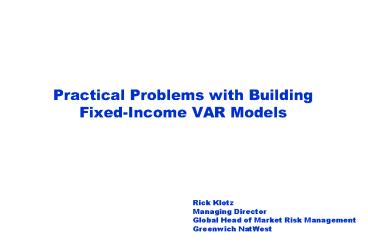Practical Problems with Building Fixed-Income VAR Models - PowerPoint PPT Presentation
Title:
Practical Problems with Building Fixed-Income VAR Models
Description:
Practical Problems with Building FixedIncome VAR Models – PowerPoint PPT presentation
Number of Views:43
Avg rating:3.0/5.0
Title: Practical Problems with Building Fixed-Income VAR Models
1
Practical Problems with Building Fixed-Income VAR
Models
Rick KlotzManaging Director Global Head of
Market Risk ManagementGreenwich NatWest
2
Value At Risk Definition
- The value at risk (VAR) of a portfolio is the
loss in value in the portfolio that can be
expected over a given period of time (e.g.,
1-Day) with a probability not exceeding a given
number (e.g., 5). - Probability (Portfolio Loss lt - VAR) K
- K Given Probability
3
Visualizing VAR An Example
- A one day VAR of 10mm using a probability of 5
means that there is a 5 chance that the
portfolio could lose more than 10mm in the next
trading day.
4
VAR and Capital Requirements For Banks
- Regulatory Capital Market Risk Capital
Specific Risk Capital Counterparty Risk
Capital - Market Risk Capital Max Ave. of 10-Day 99
VAR x Multiplier, yesterdays
10-Day 99 VAR
5
Back-Testing A VAR Model
- Calculate 1-Day 95 VAR for a (changing)
portfolio each day for some substantial period of
time (e.g., 100 Days) - Compare the P/L on the succeeding trading day
with the previous close of business days VAR - Count the number of times the loss exceeds the
VAR
6
The Need For VAR Model Accuracy
- If the VAR is systematically too low, the model
is underestimating the risk and you tend to have
too many occasions where the loss in the
portfolio exceeds the VAR. This can lead to an
increase in the multiplier for the capital
calculation. - If the VAR is systematically too high, the
model is over estimating the risk and your
regulatory capital charge will be too high
7
Building A VAR Model Estimating the Change in
the Value of the Portfolio
- Estimate the change in the value of the portfolio
P, as a function of the change in the value
of risk factors , . . ., (e.g.,
, may be the change in 1-year U.S. interest
rates, may be the change in 2-year U.S.
interest rates, etc.). - Example
8
Building A VAR Model Basic Methodologies
- 1) Variance/Covariance Method - Use historical
variances and covariances
of risk factors, , to estimate
how large 1.645 (for 5) is for the
distribution of .
9
Building A VAR Model Basic Methodologies
- 2) Historical Simulation Method - Take an
historical period, say the last 501 trading days,
and calculate - Order from highest to lowest and take
the 475th as the VAR
10
Building A VAR Model Basic Methodologies
- 3) Monte Carlo Simulation Method - Simulate a set
of 500 (for example) by choosing
for risk factors ( can be historical or
implied from options, are usually
historical). Order the from highest
to lowest and take the 475th as the VAR.
11
Model Specific Issues
12
General Challenges for VAR Models
- Obtaining Good Historical Data
- Finding a complete set of risk factors - fixed
income VAR models generally miss bond specific
information (e.g., issuer specific risk) - How to weight historical data to accurately
determine a 1-day VAR.
13
Obtaining Good Historical Data
- Poor Data
- Even actively traded markets can have noisy
historical data - Less actively traded markets can pose a
significant challenge to
finding clean historical data - Historical data can be misleading if a market is
maturing over that
period - Missing Data
- It may be difficult to find historical data in
relatively new (e.g., U.K. Asset
Backeds) or inactive markets (e.g.,
inverse I.O.s) - Asynchronous Data
- The data for risk factors that are traded
against each other (e.g., Mortgages and
Treasuries, Futures and Cash
Securities, etc.) must reflect simultaneous
closes.
14
Finding a Complete Set of Risk Factors
- Fixed Income VAR models generally miss bond (even
market) specific information - Coupon to coupon trades
- Basis trades
- Issuer specific risk
- Some market specific risks (e.g., U.K. Asset
Backeds) - Some risk factors are mapped to risk factors that
have adequate historical data but may not be good
proxies
15
How Should Historical Data Be Weighted To
Calculate a 1-Day VAR?
- Regulators require that you use at least one year
of historical data - An option trader buying or selling a 1-Day option
would give very little weight to old data































